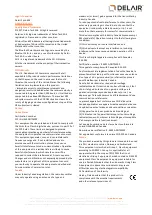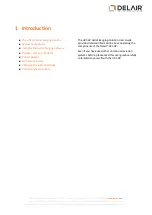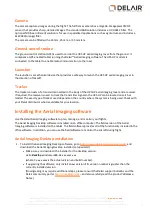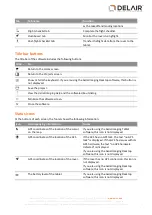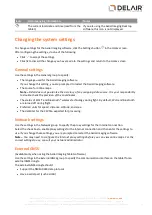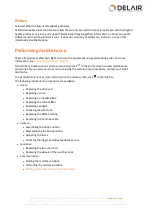
The UX5 HP aerial imaging solution
The Delair UX5 HP aerial imaging rover is an unmanned aerial vehicle (UAV). An unmanned aerial vehicle is a
generic term, and refers to an aircraft that is operated remotely. The UX5 HP aerial imaging rover follows a
pre-programmed path where takeoff, flight, and landing require minimal human intervention. If required,
the crew operating the aircraft from the ground can intervene to change the flight path or to land. In some
cases, such as communications failure or loss of GPS signal, a pre-programmed intervention is
automatically activated to re-establish signal loss or to terminate the flight early and complete a safe
landing.
The UX5 HP aerial imaging rover holds a camera that takes aerial images over the defined area. During the
flight, all pictures are acquired at a specified height, along parallel lines with specified overlap between the
image exposures. At the same time, precision GNSS-based position information is recorded during a
postprocessing kinematic (PPK) survey to achieve highly accurate position information for the captured
images. When processed in image processing software such as Trimble Business Center software, the PPK
data produces high absolute accuracy deliverables.
About postprocessed kinematic surveys
A postprocessed kinematic survey enhances the accuracy of position data derived from satellite-based
positioning systems by using data from at least two GNSS receivers: a
base
(reference) receiver and a
rover
(moving) receiver.
The base receiver remains stationary at a site with precisely known coordinates. The coordinates of the
rover are unknown. They are determined relative to the reference position using measurements recorded
simultaneously at the two receivers. The positioning accuracy obtained with this technique is usually
centimeter accuracy. This is mainly because the measurements of two (or more) receivers simultaneously
tracking a particular satellite contain more or less the same errors and biases. The shorter the distance
between the two receivers, the more similar the errors. By calculating the difference between the
measurements of the two receivers, common errors are removed and those that are spatially correlated
are reduced, depending on the distance between the reference receiver and the rover.
For a PPK survey, the data collected by the rover is processed and corrected
after
the measurements have
been made. This provides the following advantages compared to a real-time kinematic (RTK) survey:
l
More accurate results as the data throughput is not limited by the real-time communication link.
l
Communication link-related problems, such as signal obstruction or limitation of coverage, are
avoided.
l
No accuracy degradation due to data latency.
l
More accurate results due to more flexibility in editing and cleaning of the collected GPS data.
Typical applications
Image acquisition can be used for:
l
Orthophoto creation
l
Digital Elevation Model (DEM) or Digital Surface Model (DSM)
l
Photogrammetry
8
Delair-Tech
|
676, Rue Max Planck – 31670 Toulouse-Labège, France
|
Tel: +33 (0) 5 82 95 44 06
|
Capital: 238 110,30 € - APE: 3030Z – Intra-Community VAT number: FR90 53 09 69 781 – 530 969 781 R.C.S. Toulouse
This document is the sole property of Delair-Tech and cannot be used or reproduced without the written authorization of Delair-Tech
.


